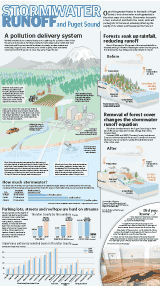
The victory is a recent ruling by Washington's Pollution Control Hearings Board, regarding a suit by environmentalists on the inadequacy of the National Pollutant Discharge Emission System. Among other things, NPDES regulates municipal and industrial stormwater discharges.
Washington is one of the states which has received federal permission to self-administer NPDES.
Our Department of Ecology is the responsible agency, and frankly they are not living up to their duty:
* Low impact development techniques are not required to control stormwater, Ecology merely suggests jurisdictions try alternative control methods
* Ecology has created 'mixing zones' around pollutant discharge points in Puget Sound, where pollution above legal limits is allowed prior to being diluted in open water -- a concept not found in the Clean Water Act.
* Permits are supposed to be revised every 5 years, but it has been 15 years since the last revision.
The PCHB agreed with environmentalists that Ecology's regulations are inadequate -- and directed they be rewritten to require low impact development techniques for new development.

This leaves out the whole issue of retrofitting -- making existing development low impact as well. Low impact techniques for new development merely lessens the rate at which stormwater increases, the total discharge continues to rise. PCHB has separated new development from retrofitting because the latter will be a highly contentious and expensive process, and why not put off what you can do today.
Ironically, a low impact best practice is on display right here in Seattle. Called Street Edge Alternative (SEA) Streets, it chiefly involves sidewalks made from permeable material, and bioswales (aka 'rain gardens') to naturally filter runoff.
SEA Streets has brought enormous benefits to the Broadview community where it was piloted. Runoff has been reduce 99%, helping protect nearby Pipers Creek, which flows into Puget Sound. The streets are curvy, reducing traffic speeds. The bioswales are attractive steps up from drainage ditches, creating a lush and verdant streetscape -- as well as separating traffic from the new water-permeable sidewalks. Broadview is one of the many areas that didn't get sidewalks after annexation to Seattle, so SEA Streets has improved basic walkability and pedestrian safety.
 |  |
 |  |
SEA Streets is a best practice, but in terms of effectiveness the program is a nonentity. Because after constructing the SEA Streets demonstration in 2001, Seattle has declined to apply the method across the city. The project exists as an amenity for Broadview, a field trip for visiting planners, and a URL for sustainability bloggers. But otherwise SEA Streets is in limbo, a pilot project that has not received wider implementation.
A large part of the problem is the transportation funding formula didn't change. In Seattle, general funds pay for the street in front of your home, but sidewalks are funded through scarce grants and by billing the homeowner, as though sidewalks are private property. At current funding levels, it could take 100 years to finish the sidewalk network.
Here's where the stormwater ruling meets pedestrian infrastructure. It might be possible community activists can use the former to leverage the latter.
The key is the retrofitting issue. While the PCHB has put off retrofitting to the next round of permittting, supposedly in five years, activists need to start be writing Ecology about it now. By letting the state know how important it is to act on retrofitting, the more likely the issue will be taken up in a timely manner.
If the regulations are rewritten to require low impact retrofitting in the Class One cities (populations greater than 20,000 -- the ones that create the most polluted stormwater), those cities become legally obligated to come up with a retrofitting strategy, designs, and an implementation and funding plan. SEA Streets would complete the pedestrian infrastructure where needed, and elements of SEA Streets applied citywide would lead to huge reductions in polluted runoff.
Link: Toxic Runoff - Silent Killer

No comments:
Post a Comment